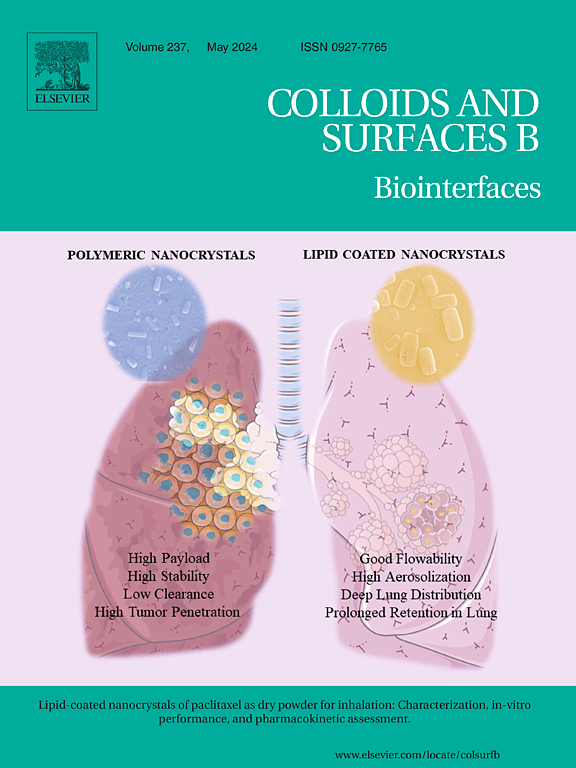Dexamethasone-loaded chitosan-decorated PLGA nanoparticles: A step forward in attenuating the COVID-19 cytokine storm?
IF 5.4
2区 医学
Q1 BIOPHYSICS
引用次数: 0
Abstract
This study aims to develop and characterize poly (lactic-co-glycolic acid) (PLGA) nanoparticles decorated with chitosan (CS) for the encapsulation of dexamethasone (DEX) (NP-DEX-CS), targeting improved efficacy in the treatment of severe acute respiratory syndrome (SARS) associated with COVID-19. The nanoparticles were systematically characterized for size, zeta potential (ZP), morphology, encapsulation efficiency, and in vitro drug release. Incorporation of CS resulted in significant modifications in the nanoparticles' physical properties, notably an increase in size (from 207.3 ± 6.7 nm to 264.4 ± 4.4 nm) and a shift in ZP to positive values (from −11.8 ±1.4 mV to +30.0 ± 1,6 mV). The NP-DEX-CS formulation achieved a high encapsulation efficiency (∼79 %) and a drug loading capacity of 6.53 ± 0.02 %.In addition, the in vitro release rate of DEX from NP-DEX-CS was lower compared to undecorated nanoparticles, with a reduction from approximately 64–37 % within 24 h. Microscopy analyses revealed a smoother surface on the CS-decorated nanoparticles. FTIR and XRD analyses confirmed successful chitosan coating and DEX encapsulation. The CS coating enhanced the tolerability of J774.A1 cells to the nanoparticles, particularly evident at the highest concentration (400ug/mL), resulting in a cell viability ≥70 %. Importantly, the NP-DEX-CS significantly reduced levels of nitric oxide and inflammatory cytokines (IL-1, IL-6, IL-12, and TNF-α). These findings suggest that CS-decorated PLGA nanoparticles hold promise as an effective dexamethasone delivery system for treating SARS related to COVID-19.
地塞米松负载壳聚糖装饰PLGA纳米颗粒:在减弱 COVID-19 细胞因子风暴方面向前迈进了一步?
本研究旨在开发和表征用壳聚糖(CS)装饰的聚(乳酸-共聚-乙醇酸)(PLGA)纳米粒子,用于包封地塞米松(DEX)(NP-DEX-CS),以提高与 COVID-19 相关的严重急性呼吸系统综合征(SARS)的疗效。对纳米颗粒的尺寸、ZP、形态、封装效率和体外药物释放进行了系统表征。CS 的加入使纳米颗粒的物理性质发生了显著变化,尤其是尺寸增加(从 207.3 ± 6.7 nm 增加到 264.4 ± 4.4 nm),ZP 变为正值(从 -11.8 ± 1.4 mV 增加到 +30.0 ± 1,6 mV)。此外,NP-DEX-CS制剂的DEX体外释放率低于未装饰纳米颗粒,在24小时内降低了约64-37%。显微镜分析表明,经 CS 装饰的纳米颗粒表面更光滑。傅立叶变换红外光谱和 XRD 分析证实壳聚糖涂层和 DEX 封装成功。CS 涂层增强了 J774.A1 细胞对纳米粒子的耐受性,这在最高浓度(400ug/mL)时尤为明显,细胞存活率≥70%。重要的是,NP-DEX-CS 能显著降低一氧化氮和炎症细胞因子(IL-1、IL-6、IL-12 和 TNF-α)的水平。这些研究结果表明,CS装饰的PLGA纳米颗粒有望成为一种有效的地塞米松输送系统,用于治疗与COVID-19相关的SARS。
本文章由计算机程序翻译,如有差异,请以英文原文为准。
求助全文
约1分钟内获得全文
求助全文
来源期刊

Colloids and Surfaces B: Biointerfaces
生物-材料科学:生物材料
CiteScore
11.10
自引率
3.40%
发文量
730
审稿时长
42 days
期刊介绍:
Colloids and Surfaces B: Biointerfaces is an international journal devoted to fundamental and applied research on colloid and interfacial phenomena in relation to systems of biological origin, having particular relevance to the medical, pharmaceutical, biotechnological, food and cosmetic fields.
Submissions that: (1) deal solely with biological phenomena and do not describe the physico-chemical or colloid-chemical background and/or mechanism of the phenomena, and (2) deal solely with colloid/interfacial phenomena and do not have appropriate biological content or relevance, are outside the scope of the journal and will not be considered for publication.
The journal publishes regular research papers, reviews, short communications and invited perspective articles, called BioInterface Perspectives. The BioInterface Perspective provide researchers the opportunity to review their own work, as well as provide insight into the work of others that inspired and influenced the author. Regular articles should have a maximum total length of 6,000 words. In addition, a (combined) maximum of 8 normal-sized figures and/or tables is allowed (so for instance 3 tables and 5 figures). For multiple-panel figures each set of two panels equates to one figure. Short communications should not exceed half of the above. It is required to give on the article cover page a short statistical summary of the article listing the total number of words and tables/figures.
 求助内容:
求助内容: 应助结果提醒方式:
应助结果提醒方式:


